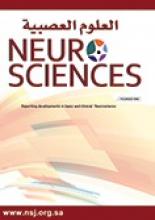Abstract
OBJECTIVE: To describe the clinical profile of Lennox-Gastaut syndrome (LGS) patients and to assess the best antiepileptic drug combination.
METHODS: Patient files of all children diagnosed with LGS at King Abdul-Aziz University (KAUH), Jeddah, Kingdom of Saudi Arabia between January 2000 to January 2005 were retrieved and analyzed. Details on clinical data, and disease related variables were collected. Treatment trial, last drug combination, maintenance dosage, seizure frequency, and duration before and after treatment, and the overall effect in reducing seizures were recorded.
RESULTS: Fifty-four patients were identified with a male:female ratio of 2.4:1 with age range of 10 months to 14 years. A history of febrile convulsion was found in 11 (20%) patients, history of infantile spasm was found in 14 patients (26%), mental retardation in 52 patients (96%), and hypotonia in 13 patients (24%). All patients had abnormal EEG that meets the diagnostic criteria. Brain CT scan was abnormal in 32 (65%) patients. Brain MRI was abnormal in 17 (23%) patients. Neuroradiological abnormalities varied from non-specific atrophy to hippocampal sclerosis and calcification. Metabolic screening carried out for 11 patients (20%) was normal. All patients were on a 3-drug combination at some stage of their disease. The most frequent combination was sodium valproate and lamotrigine. Intravenous immunoglobulin was used in 2 patients with temporary improvement; ketogenic diet was tried in one patient, which did not add much to fit control.
CONCLUSION: The severe nature and intractability of LGS emphasize the need for active and efficacious treatment, which can improve the prognosis as a whole. Different combinations of new anticonvulsants could achieve significant seizure control and could modify the quality of life for these patients. Each patient needs to be considered individually, taking into account the potential benefit of each therapy weighed against the risk of adverse effects.
- Copyright: © Neurosciences
Neurosciences is an Open Access journal and articles published are distributed under the terms of the Creative Commons Attribution-NonCommercial License (CC BY-NC). Readers may copy, distribute, and display the work for non-commercial purposes with the proper citation of the original work.






